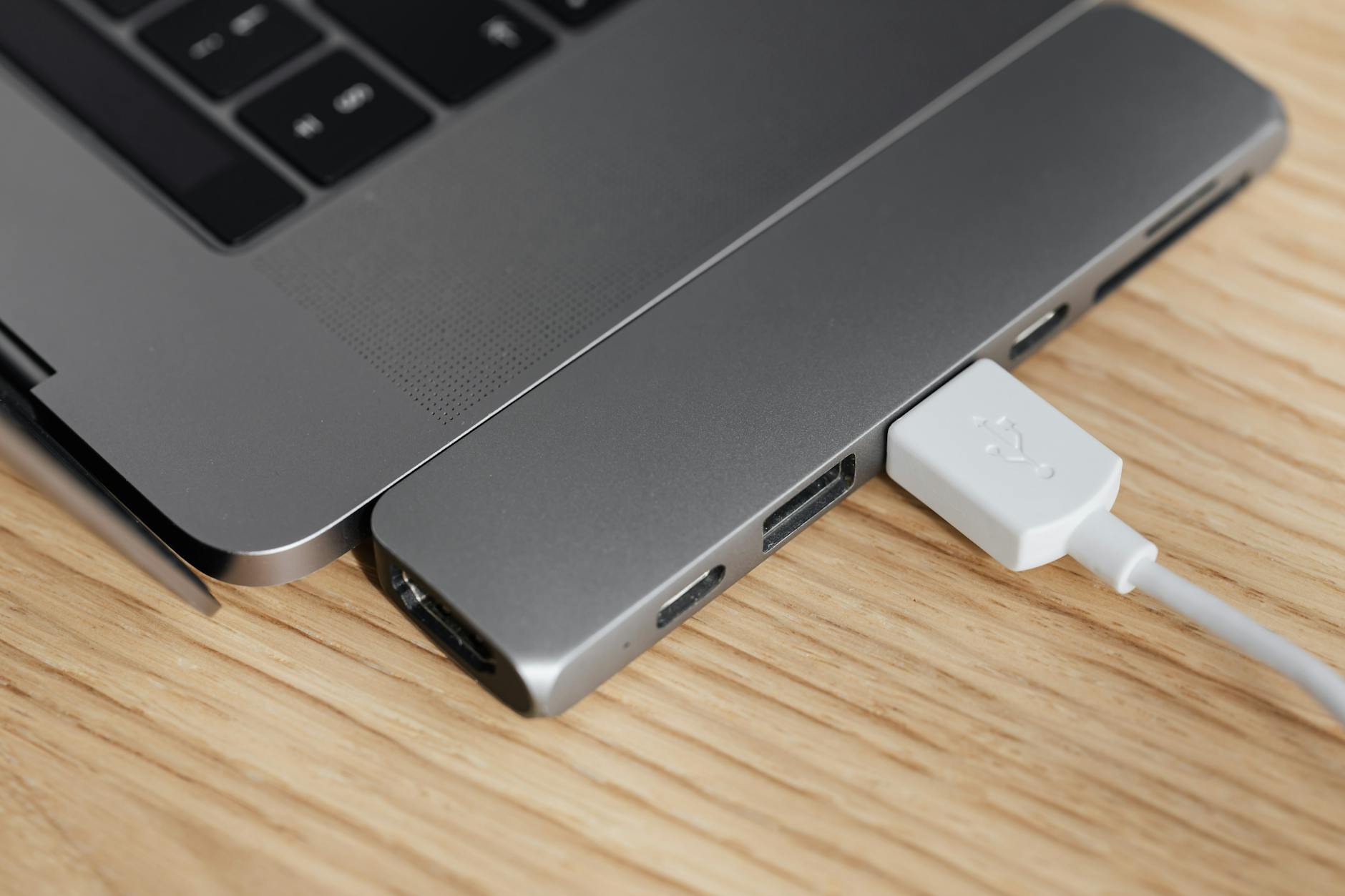Smart Devices: Hub or Laptop Power for US Connections
Unlock seamless US connections in 2025! Explore smart devices, hubs vs. docking stations, and optimize your digital life.
Smart Devices: Hub or Laptop Power for Your US Connection in 2025?

Image source: Pexels
Is your digital life in 2025 a tangled web of devices and frustratingly slow connections? Are you eyeing a smart home hub as the missing piece for a truly seamless experience in the US? You're far from alone. As our reliance on technology deepens, understanding how various smart devices – from robust docking stations to centralized hubs – weave our digital world together is paramount. This guide is your roadmap to demystifying the essential smart device technologies defining your US connection this year. We'll unravel docking stations and hubs, explore the burgeoning US smart home hub market, and weigh portable WiFi against phone tethering. Prepare to optimize your laptop’s potential and build the connected smart home you’ve been dreaming of, with practical advice designed to elevate your 2025 digital experience.
Smart Devices: Hubs vs. Docking Stations in 2025
As our reliance on interconnected smart devices grows, understanding the nuances between different connectivity solutions becomes crucial for optimizing your digital workflow in 2025. Discerning between a docking station and a hub is essential, as they serve distinct purposes and offer varying levels of functionality.
Docking Station vs. Hub: What's the Difference?
The fundamental distinction lies in their scope and power. Docking stations often provide robust power delivery and extensive ports for a full workstation setup, acting as a central power source for your laptop and peripherals. They transform a portable device into a stationary powerhouse. Hubs, on the other hand, are typically more portable, designed to expand existing laptop ports and offer basic connectivity for everyday use, often drawing power from the laptop itself.
Docking Stations: Powering Your Laptop Productivity
Docking stations in 2025 are engineered for peak productivity. They offer a comprehensive solution for users requiring multiple displays, high-speed data transfer, and a stable wired network connection. Connecting a single cable to your laptop for power, data, and video output streamlines desk setup and reduces cable clutter. This centralized approach is ideal for creative professionals or those managing complex projects needing simultaneous access to various peripherals and large datasets.
Hubs: Portable Power and Connectivity Expansion
Hubs excel in scenarios demanding flexibility and on-the-go connectivity. They are perfect for expanding the limited ports on modern ultra-thin laptops, allowing users to connect external drives, keyboards, and an additional monitor without compromising portability. While they might not offer the same power delivery as a docking station, they provide essential functionality for everyday tasks, making them indispensable smart devices for mobile professionals and students.
Choosing the right device for your 2025 workflow hinges on your primary use case. Extensive multi-display setups and high-speed data transfer lean towards docking stations, while on-the-go expansion and basic port addition favor hubs. Understanding the ‘power' each device offers is key: docking stations can power your laptop and accessories, while hubs primarily expand connectivity.
The 2025 US Smart Home Hub Market: Powering Your Connected Life
The year 2025 marks a significant evolution in the US smart home landscape, with the smart home hub solidifying its position as the indispensable brain behind our increasingly connected lives. These central devices are no longer niche gadgets but essential components for orchestrating a symphony of smart devices, from lighting and climate control to robust security systems. As more households embrace the convenience and efficiency of smart technology, understanding the hub's role and underlying technologies becomes paramount for a truly integrated and automated living experience.
Defining the Smart Home Hub: Your Central Command Center
A smart home hub acts as the central nervous system for your connected ecosystem. Its primary function is to enable disparate smart devices, which might otherwise operate in isolation, to communicate seamlessly with each other and with you. This interoperability is key to unlocking the full potential of smart home technology, allowing for complex routines and automated actions. For instance, a hub can be programmed to dim the lights, adjust the thermostat, and arm the security system when you say “goodnight,” creating a truly unified experience with your various smart devices.
Key Technologies Driving Smart Home Interoperability
The magic of a smart home hub lies in its ability to support a variety of communication protocols. Wi-Fi is ubiquitous, connecting many smart devices directly to your home network. However, for robust and low-power communication, protocols like Z-Wave and Zigbee are crucial. These mesh networking technologies are designed specifically for smart home applications, ensuring that devices can reliably “talk” to each other, regardless of their brand. A hub that supports a wide range of these protocols offers greater flexibility and broader compatibility with the ever-expanding array of smart devices available on the market.
Market Trends in the 2025 US Smart Home Ecosystem
The US smart home market is experiencing sustained growth in 2025, driven by an increasing consumer appetite for integrated automation and convenience. Key trends include a strong emphasis on voice control, with hubs increasingly leveraging AI assistants for intuitive command and control. Furthermore, energy management solutions are gaining traction, allowing users to monitor and optimize their home's energy consumption through smart thermostats and lighting systems. The focus is shifting from individual smart devices to a holistic, interconnected experience powered by intelligent hubs.
How to Choose a Hub for Seamless Home Automation
Selecting the right smart home hub is crucial for a frustration-free automation experience. When making your choice, prioritize compatibility with your existing or planned smart devices. Research which protocols the hub supports and ensure it aligns with the devices you intend to connect. Equally important is considering the ease of setting up home automation routines. Look for intuitive app interfaces and clear instructions that simplify the process of creating personalized schedules and triggers for your smart devices. A well-chosen hub will empower you to truly leverage the potential of your connected home.
Portable WiFi vs. Phone Tethering: Your 2025 Connectivity Solution
In 2025, staying connected on the go is more crucial than ever, especially with the increasing reliance on Smart Devices for work, entertainment, and communication. Two primary methods for achieving this mobile internet access are portable WiFi routers (often called mobile hotspots) and phone tethering. This section will delve into the nuances of each, helping you determine the most suitable solution for your needs.
Understanding Mobile Hotspots and Phone Tethering
Phone tethering, also known as personal hotspot, allows your smartphone to share its cellular data connection with other devices via WiFi, Bluetooth, or USB. It's a convenient feature built into most modern smartphones. Portable WiFi routers, on the other hand, are dedicated devices that use a separate SIM card and cellular data plan to create a private WiFi network. These devices are designed to offer a more robust and stable internet connection, often supporting more simultaneous connections than a typical smartphone can handle.
Data Use, Costs, and Limitations in 2025
When evaluating connectivity solutions, data usage, costs, and limitations are paramount. Phone tethering can quickly deplete your mobile phone's data allowance, especially when multiple devices are connected or streaming high-definition content. Furthermore, it can significantly drain your phone's battery. Portable WiFi routers, while requiring a separate data plan, often offer larger data caps or unlimited data options, making them more suitable for heavy usage. Roaming charges can also be a significant consideration; a dedicated portable WiFi device might offer more predictable international plans than relying on your primary mobile carrier.
The Benefits of Dedicated Portable WiFi Routers
Portable WiFi routers (mobile hotspots) offer a dedicated, often more stable and powerful internet connection for multiple devices compared to phone tethering. This is particularly beneficial for households or small groups relying on multiple Smart Devices simultaneously, such as laptops, tablets, and smart TVs. Their dedicated nature means they are optimized for broadcasting a strong WiFi signal and managing multiple connections efficiently, leading to a smoother online experience for all connected devices.
Which Connection Method is Right for Your Needs?
For consistent, reliable internet access on the go in 2025, especially for multiple users or demanding tasks, a dedicated mobile hotspot is often the superior choice. If you primarily need occasional internet access for one or two Smart Devices and have a generous mobile data plan, phone tethering might suffice. However, for frequent travelers, remote workers, or families with numerous connected gadgets, investing in a portable WiFi router will likely provide a more robust, reliable, and cost-effective solution in the long run.
FAQ (Frequently Asked Questions)
Q1: What is the primary difference between a smart home hub and a docking station?
A1: A smart home hub acts as a central controller for various smart devices in your home, enabling them to communicate and automate tasks. A docking station, on the other hand, is primarily designed to expand the connectivity of a laptop, providing more ports for peripherals, external displays, and often charging capabilities, transforming it into a desktop workstation.
Q2: Which protocol is best for smart home devices: Wi-Fi, Z-Wave, or Zigbee?
A2: The “best” protocol depends on your needs. Wi-Fi is good for high-bandwidth devices but can be power-hungry. Z-Wave and Zigbee are excellent for low-power, reliable communication between smart home devices, forming mesh networks that extend coverage. Many hubs support multiple protocols for maximum compatibility.
Q3: Can I use my smartphone as a portable WiFi hotspot indefinitely?
A3: While convenient for short periods or limited use, relying on your smartphone as a permanent portable WiFi hotspot can quickly deplete your data allowance, lead to high costs, and significantly drain your phone's battery. For consistent and heavy usage, a dedicated portable WiFi router is a more efficient and reliable solution.
Q4: How important is port variety when choosing a docking station in 2025?
A4: Port variety is highly important for a docking station. It dictates what peripherals you can connect simultaneously, such as multiple monitors (HDMI, DisplayPort), external hard drives (USB-A, USB-C), wired internet (Ethernet), and audio devices. Ensure the docking station has the necessary ports to support your specific workstation setup.
خاتمة
As we navigate the increasingly interconnected landscape of 2025, smart devices are no longer mere accessories but foundational pillars of our digital existence. Whether your priority lies in augmenting your laptop's capabilities with a robust docking station, orchestrating a truly unified smart home experience through a central hub, or ensuring unwavering connectivity on the move with portable WiFi, a nuanced understanding of each solution's core functionality, inherent benefits, and potential limitations is paramount. Making informed decisions today is the key to unlocking a future of seamless, efficient, and empowering digital connections.
To truly harness the power of smart devices, begin by evaluating your unique connectivity needs. Are you yearning for expanded laptop ports to fuel your productivity? Do you envision a more intelligent and responsive home environment? Or is reliable, high-speed mobile internet your ultimate goal? Once your needs are clear, research devices that align with your requirements, paying close attention to protocol compatibility – think Z-Wave for sophisticated home automation – and ensuring they fit comfortably within your budget. Crucially, consider the long-term ‘power' and ‘interoperability' each potential solution offers, guaranteeing a future-proof and integrated digital ecosystem.
Share your biggest connectivity challenge in the comments below! Let's build a community of informed users. And don't forget to subscribe for more insightful articles on smart devices and how to optimize your digital life in 2025. Together, we can ensure your US connection is not just functional, but truly brilliant.








